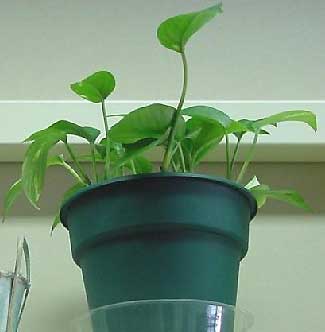Monday, February 14, 2005
Office gardens
 I don't know about you, but there was a time I was working in a luxurious 6 foot by 6 foot cubicle. You're probably scoffing and thinking "luxurious"? Well, yes. The alternative was a 4 foot by 6 foot cubicle and I just happened to be high enough on the totem pole that I earned the 6 by 6 size. Anyway, cubicles and the cubicle environment work well for a business but not necessarily for the folks who have to work there. So it's kind of nice when there is an opportunity to view some greenery and not just through the occasional window.
I don't know about you, but there was a time I was working in a luxurious 6 foot by 6 foot cubicle. You're probably scoffing and thinking "luxurious"? Well, yes. The alternative was a 4 foot by 6 foot cubicle and I just happened to be high enough on the totem pole that I earned the 6 by 6 size. Anyway, cubicles and the cubicle environment work well for a business but not necessarily for the folks who have to work there. So it's kind of nice when there is an opportunity to view some greenery and not just through the occasional window. I received an email the other day from the HGTV website talking about cubicle gardens, which took me on the mind journey I mention above. Luckily I no longer work in a cubicle environment but I do remember having a plant or two around to brighten the area up and make it seem more homey. The HGTV newsletter recommends low light plants such as "pothos, aluminum plant (Pilea cadierei), jade plant (Crassula argentea), kentia palm (Howeia forsteriana), snake plant (Sansevieria trifasciata), peace lily (although it won't flower in low light) and possibly two of the most tolerant of low-light conditions, the Chinese evergreen, or Aglaonema modestum (10 foot-candles), and cast-iron plant (Aspidistra elatior)."
Here's something I knew intuitively that was confirmed by the newsletter - most indoor plants don't die from neglect. The culprit is overwatering. We worry so much about taking proper care of the plants that we wind up killing them with kindness, literally. There are a couple of things you can do to avoid overwatering. One is to use a moisture meter - they are available in all garden stores and let you know when the plant is thirsty. The other way to test the soil - use your finger. Put your finger in the soil below the surface. If it feels dry add some water. If it feels moist don't. Ah, the magic of fingers. The newsletter also recommends providing humidity. Most office conditions are pretty darn dry, so you'll need to keep a mister nearby. Spritz the leaves a few times a week. You'll have a happy plant and a happier environment in which to work. Happy Gardening.
Comments:
Post a Comment

This work is licensed under a Creative Commons License.
Thanks to Andrew Stenning who contributed the photograph for our masthead


